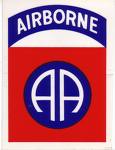

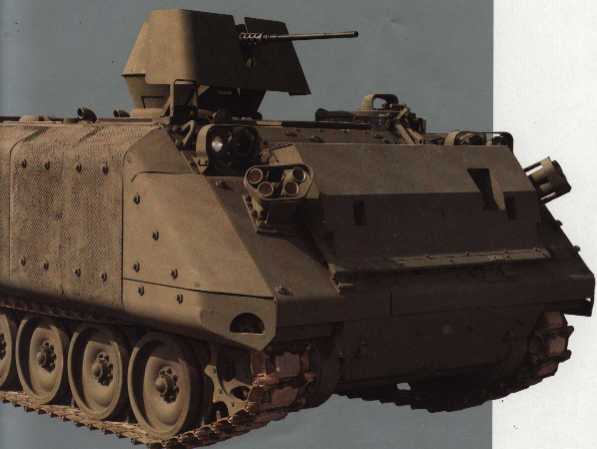

LTC Martin Stanton's call in the Jan-April 1998 issue "The JAVELIN and BFV Infantry: What is Really Important?" of U.S. Army
Infantry Magazine for a separate platoon of Javelin ATGMs moved by M113A3 Gavin Armored Fighting Vehicles within the Bradley infantry battalion needs to be duplicated within the Airborne Infantry Battalions of the 82nd Airborne Division in light of the retirement of the M551 Sheridan light tank and the cancellation of the M8 Armored Gun System. The Javelin is a "double-threat" weapon that can kill tanks from the top-down without continuous user guidance, shoot down slow moving aircraft and demolish buildings/bunkers; vital on a rapidly urbanizing AIRLAND battlefield.
Airborne infantry has always been overloaded. This problem is compounded by the platoon's many weapons. An Airborne infantry platoon leader has four Medium Anti-Tank Guided Missiles (ATGMs: Dragons or Javelins), two ATGM launchers, two M60/M240B Medium Machine Guns, 6 x M249 Light Machine Guns, and 6 x M16A2 Rifle/M203 grenade launchers, as well as everyone else carrying M16A2 rifles, all that has to be carried in the Paratrooper's hands or on their backs. All the studies of the Soldier's Load have concluded carried weight must not exceed 1/3 of the Soldier's body weight, but we only end up playing "fast and loose" with load planning statistics (Read FM 21-18 Foot Marches incorrect equipment weights or THE SOLDIER'S LOAD
1LT Scott C. Porter, Infantry Magazine May-June, 1992) rather than SOLVING the problem with bold systemic changes.
The current concept of 3x9+9 (three squads of 9 men each plus a 9-man weapons squad) in an Airborne infantry platoon is sound.
However, we have been working with Airborne infantry for over 50 years now, and the men are still overloaded, unable to travel faster than 1-2 mph. WWII Darby's Rangers could go 7 mph, todays IDF Paratroopers can "speed march" from a distant drop/landing zone, keeping the sounds of their delivery aircraft out of earshot of the enemy, then rapidly close to destroy the target with surprise and shock effect. If we are to be successful, we have to make some hard choices: Just how fast must Airborne infantry move to be successful on the modern battlefield? 4-7 mph should be our goal in EVERYTHING WE DO. That starts with Paratrooper load plans and the physical training we do daily. A Soldier's load planning reduction acronym must be in the 5-paragraph operations order or else all talk becomes platitudes and cliches. DROP---Decide mobility level in mph to accomplish mission, Reduce unecessary equipment, Organize other transportation means, Police the ranks so un-needed gear is not carried. We have to come to terms with the fact that Airborne infantry is not like other infantry; everything must be air-delivered by parachute from USAF aircraft, traveling world-wide. This is the reality of the power-projection Army.
The weapons required for these tasks are always individual close-range weapons: 14.8 pound M136 ("AT4") 84mm "light" anti-tank/assault rockets, 15 pound 5.56mm M249 LMGs, 11 pound 40mm M203 grenade launchers with or without 5.56mm Ml6 assault rifles, and hand grenades. As a result, we must make a conscious effort to eliminate the clutter and bulkiness of the crew-served weapons/equipment the Airborne infantry must carry, their ATGMs and MMGs. The replacement of full-size M16A2 rifles with M4 5.56mm Carbines that are more compact is a step in the right direction since these can be jumped without the bulky M1950 individual weapons case, one less thing hindering the Paratrooper from exiting the door without snagging for a tight body position exit and good canopy opening. However to gain the improved reliability and longer range of the M240B MMG over the M60, the Machine Gunner has to carry a weapon that has increased from 23 pounds to 27 pounds, and now has a flex-mount to dampen shock when fired from the M122 tripod. Hopefully a new M122E1 aluminum tripod will cut weight from 15 pounds to under 5 to make up for this increase. The two M6O/M240B MMGs should be retained within the platoon for the superior grazing fire range of a 7.62mm Medium Machine Gun to defend a dismounted avenue of approach or for a devastating base-of-fire using tripods with traversing and elevating (T&E) mechanisms, and spare barrels for sustained fire. Instead of being carried bare metal in the hands of the Paratrooper Machine Gunner, Tripods and flex-mounts (M240Bs) can be best carried using Spare Barrel Bags modified on the outside with stowage pockets and quick-release straps so everything is covered when the Paratrooper exits the jump door with the spare barrel bag strapped to his rucksack as a lowering line load. When used in the assault, the M60/M240B uses a plastic ammo box to hold 100 rounds ready to fire attached to the gun, until a tripod mounted firing position can be attained. This frees the Assistant Gunner to actually spot for the Gunner or to fire his own 5.56mm weapon instead of holding the 7.62mm belt up.
50-pound Javelin ATGMs (missile and Command Launch Unit) should be dropped as door bundles and be later moved by human powered mobility devices like All-Terrain, All-purpose Cart/Sleds (ATACSs)held inside the A-7A strap door bundle. Other Javelin ATGMs moved by 11-ton (weighs the same as FMTV 2.5/5-ton trucks) M113A3 tracked Armored Fighting Vehicles (AFVs) assigned to a designated platoon in the Airborne Infantry Battalion's Anti-Tank "D" Company.
In the attack, the Airborne infantry-freed of the complications of its heavier crew-served weapons -- would be able to place more men in the actual assault while being supported by the direct fire of the Weapons Squad and Anti-tank Company. We need three coherent squads jumping with prudent combat loads, seconds later moving on the ground with well-thought out, easy to carry and operate gear, with intelligent mechanical advantage instead of a platoon (minus) mob of guys with their hands full struggling to carry heavy weapons that are ill-designed for close assault. In the defense, the infantry secures obstacles, provides local security for vehicles, and can also provide defense on a dismounted avenue of approach.
Any way you look at it, the Javelin ATGM is a neat piece of gear. It is more accurate than the Dragon, and it has twice the range (2,000 meters). Unfortunately, the current philosophy of one-for-one replacement for the Dragon leads us right back to the overloaded Airborne infantrymen.
JAVELIN A.T.A.C.S. DOOR BUNDLES

The problem with equipping the Airborne infantry company with the Javelin is that it weighs 50 pounds and is really not suited to individual jumping. Clearly, we don't have the manpower to be lugging Javelin systems around (just as they really couldn't lug Dragons around). By equipping the Airborne infantry platoons with Javelins, the Army is virtually guaranteeing that everyone will be reduced to the 1-2 mph walking pace of the slowest Javelin AT specialist.
Javelins do bring a unique man-portable, "fire-and-forget", zero-launch signature punch to the battlefield. I would never propose that they be left out of the Airborne infantry battalion. What I do propose, however, is that they be given All-Terrain All-Purpose Cart/Sleds (ATACSs) which can be rigged inside Javelin A-7A strap door bundles for Javelin gunners jumping immediately after them to recover them on the drop zone and TOW them into action. Javelin A-7A strap door bundles or "Squad Accompanying Loads" should be mounted on a piece of truck bed liner or SKEDCO plastic so there will be directional ribs to insure the bundle doesn't slide back against the door edge, but will slide OUT into the air stream for its Javelin AT Paratroopers to follow.
M113A3 JAVELIN PLATOON IN THE AIRBORNE ANTI-TANK DELTA COMPANY
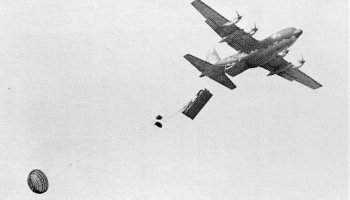
Javelins also need to be placed in a separate organization of their own with their own air-droppable, all-terrain, tracked vehicle transport. The in-service M113A3 Gavin tracked AFV is easily airdropped compared to 2.5/5 ton trucks and is as easy to maintain.
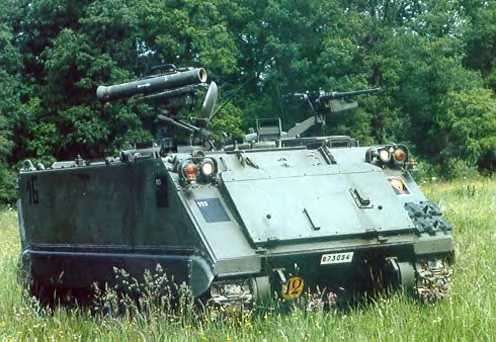
Simple Javelin ATGM mounts now test-fired on HMMWVs could be fitted to M113A3 Gavins
Specifically, I propose the creation of a single antitank platoon-a Javelin platoon-in the Airborne Infantry battalion's Anti-tank "D" company now equipped with TOW ATGM HMMWVs. This platoon would operate either their TOW HMMWVs or the M113A3s with Javelin mounts based on the Airborne Battalion Commander's direction, thus requiring no change in existing personnel organization. This would give the Airborne task force commander an air-droppable armored, all-terrain-mobile Javelin capability. M113A3 applique' armor protects the Airborne infantry from artillery, small arms, autocannon fire and RPGs.
The Airborne infantry battalion's Javelin platoon should consist of two sections of two systems each. It should have 6 x Ml13A3 Gavin vehicles -- one for the platoon leader, one for the platoon sergeant, and four for the two sections -- with a total of two Javelin systems carried on each. The 3-man crew now used to operate the TOW ATGM HMMWV would change to a Track Commander (TC), Driver and Javelin ATGM "gunner". The Javelins would be fired from the dismounted position primarily, though it can be fired from the top troop hatch using its unique soft-launch feature.
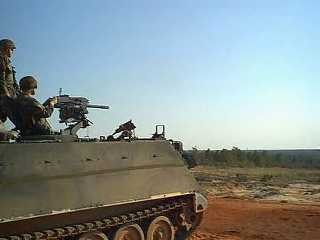
The TC hatch would have a Mk-19 Grenade Machine Gun fitted which has the same 2,000+ meter effective range as the Javelin has. The TC would fire HE and HEDP 40mm ammunition to suppress enemy infantry in support of Javelin ATGM firing/displacement as well as kill enemy light armored vehicles using the Mk-19's top-down flight trajectory. The 197th Infantry Brigade mounted Mk-19s on M113s effectively during the Gulf War, and the details are contained in FM 23-27 Mk-19 Mod O 40mm Grenade Machine Gun states:
To mount the MK 19 on the commander's cupola, install the pintle adapter and the gun cradle. Mount the MK 19 and attach the bracket mounting assembly and the empty case catch bag.
NOTE: Firing from the cupola is commonly referred to as "free gun". The suggested position for firing free gun is standing with the elbows close to the body, the hands on the control grips, the thumbs on the trigger, and the MK 19 close to the chest
attach ammo can bracket to cradle
The M113A3 with external fuel tanks free ample room inside the hull for dozens of Javelin ATGMs to be carried. In fact, SOP should be for an Airborne Infantry Platoon be attached to the Javelin ATGM platoon's M113A3s for dismounted security and additional Javelin launchers.
The following is a suggested breakdown of tasks for the M113A3 Javelin AT platoon + Airborne dismounted infantry team:
In the Offense:
Clear an area for aircraft operations
Breach obstacle
Spearhead an Assault
Clear a trenchline
Clear a building in military operations on urban terrain (MOUT)
using assault ladders bungee corded to outside of vehicle's applique' armor
Provide local security for the vehicles
Be a mobile reserve force on the drop zone, recon & security zone of airhead
In the Defense:
Defend area, obstacle
Provide local security for vehicles
Man observation post (OP), security patrols
Defend along avenues of approach
Defend in MOUT: building defense
In the defense, the Javelin platoon would be emplaced on terrain that is not suited for vehicle-mounted anti-tank systems such as TOW HMMWVs -- hillsides, ridges, the sides of ravines, or upper stories of buildings in a MOUT environment. With its Ml13A3 Gavin hull-down with Mk-19 40mm GMG ready to suppress/destroy enemy infantry a Javelin squad would be free to prepare positions, allowing for maximum system survivability. Ideally, each system should have several alternate firing positions with prestocked ammunition using All-Terrain All-Purpose Carts to shuttle extra missiles into position. These positions would have to be within running distance of each other. In MOUT, the Javelin's soft-launch feature makes it ideal to be fired from buildings, while its firer can move to cover behind a wall. The Javelin, unlike earlier TOW and Dragon Semi-Automatic Command Line-of-Sight (SACLOS) guidance systems does not have wires trailing out that cannot be fired near or over telephone/power lines, water and vegetation.
A key consideration for the employment of the Javelin platoon is its rate of fire. Although the Javelin has twice the range of the Dragon-with a much higher hit/kill probability-it still has a relatively slow rate of fire compared to gun systems. But its rate of fire is much faster than a Dragon or TOW ATGM which must be tracked by the Soldier all the way to the target, which can in itself take about 30 seconds. In contrast, the Javelin AT Soldier is free immediately after firing to reload since the Javelin doesn't require continuous tracking guidance, has no backblast signature, and fire at another acquired target. At three missiles a minute, the Javelin platoon in itself may not generate enough volume of fire to destroy a large armored formation in the same manner as a tank or a Bradley platoon could, but the limiting factor here is THE NUMBER OF JAVELIN MISSILES AVAILABLE for firing. Get a large stockpile of Javelin missiles near the Javelin AT Soldier's multiple firing positions, and the comparison then is the speed of a tank crewman loading a 120mm main gun round versus the Assistant AT Soldier attaching the Javelin ATGM missile to the CLU held by the Javelin AT Soldier already acquiring a new target. A modern stabilized turret tank can be moving and still fire, but is exposed by its noise, dust and thermal (heat) signature when doing this. The Javelin AT Soldier is static but is camouflaged, dug-in and can use his CLU's FLIR to detect and target the tank. The M113A3 Javelin platoon has 4 x Mk-19 40mm GMG fires to destroy enemy light armored/soft-skin wheeled vehicles as well as dismounted infantry and has the AT4/SMAW-D rocket fires of the dismounted Airborne infantry to bolster AFV killing power exponentially as the enemy closes under 1,000 meters. With armored tracked vehicle mobility, the Javelin AT Teams and infantry platoon dismounts can displace to alternate ambush positions and not have to stand and fight to decisive engagement from just one general location. Foot-mobile Airborne Infantry platoons with All-Terrain All-Purpose Carts can move 2-3 times the number of Javelin missiles than can be manpacked, 8 or 12 kills versus just 4, using similar tactics. Units of fire is the main problem with the Javelin-getting as many possible by the AT Team is the key.
In offensive operations, the Javelins role is to provide support-by-fire and overwatch exploiting its infared "thermal" observation capability. In a daylight, open-terrain environment such as the National Training Center (NTC), or in a real war defense as in Operation Desert Shield, the ability of the Javelin AT teams to dismount and climb to vantage points that would not be available to typical vehicle-mounted systems gives the Airborne battalion task force a capability it otherwise does not have. The Mk-19 40mm GMGs can be ground mounted away from their M113A3 AFVs if needed to get them into firing position to support the Javelin AT team's engagement. The trajectory of the Mk-19 allows it to be employed UNDER available terrain rises to mask firing signature and provide terrain protective cover using gunnery tables, range card and a spotter. The armored mobility of the M113A3 Gavin Anti-Tank platoon in the battalion anti-tank company (6 M113A3s in each battalion, 18 M113A3s in each ready brigade (325th PIR, 504th PIR "Devils in Baggy Pants", 505th "Falcons")creates 54 total in the 82nd Airborne Division motor pool, making up for the loss of the 56 x M551 Sheridan light tanks when 3/73rd Armor battalion was disbanded) enables the Airborne Infantry to conduct a flexible, area defense instead of a linear "line-in-the-sand", "speed bump" defense easily pierced. The M113A3 Gavin/Javelin combination enables the "All Americans" to duplicate their urban combat successes in Panama where enemy resistance was quickly overcome with air-dropped AFV firepower, resulting in the capture of enemy leader Manuel Noriega and a clear U.S. military vistory.
The distance from the vehicle to the firing position and the difficulty of the terrain involved -- plus the number of missiles that have to be carried to provide overwatch or support-by-fire -- may dictate that each Javelin squad carry only one of its two systems and the other squad members carry ammunition, radios, and the like. Adoption of ATACs can remedy this for full units of fire to be utilized.
The Javelin squads' infiltration on foot to a hidden support-by-fire position before line-of-departure time is where a Airborne task force commander may want to conduct a separately timed movement with his M113A3 Gavin-Javelin AT mounted infantry element moving ahead of the Paratroopers on foot main body. The dismounted infantry assists or protects the dismounted Javelin elements in their movement to support-by-fire positions, and then moves to remount their M113A3s and continue the attack. Key planning considerations in this are, once again, the number of Javelin systems and the number of rounds to be carried. At least four rounds per system would be needed for an effective overwatch or support-by-fire position.
In the attack, the M113A3 Javelin AT platoon, at least initially, would be on the battalion task force net. In support of company teams in action on the objective, however, the overwatching Javelin element would have to be on the assaulting company team's net as well. The Javelin platoon leader should be able to monitor two nets simultaneously, which would cause him to drop off the battalion net to provide responsive overwatch and receive fire directions from the assaulting unit. Arrangements within the Javelin platoon would have to be made for monitoring the battalion task force net, probably within the platoon sergeant's vehicle.
PEACEKEEPING OPERATIONS
During stability and support operations in an environment with no armored threat, the Javelin platoon could be useful in several secondary roles. There are still "vehicle" threats like suicide cars/trucks full of explosives that must be stopped by superior barriers created by earth and M113A3s as "Tropic Lightning" Vietnam combat vet Michael Meacham critiqued Camp Able Sentry in Macedonia in the Jan-April 1998 Infantry. The availability of a platoon with six Ml13A3s and 30+ Paratroopers would give the Airborne task force commander incredible flexibility to accomplish a stability and support operation (SASO). The Javelin systems help the platoon monitor and surveil for signs of the enemy using its Command Launch Unit (CLU)'s forward looking infared (FLIR). Ideally, each vehicle could be configured much like the old Vietnam-era Ml13 ACAV with one Mk-19 GMG or M2 .50-caliber HMG in the TC's armored cupola and two M60/M240B Medium Machine Guns on shielded pintle mounts. This would give the platoon formidable machinegun firepower, and enough compact M4s and M203s should be made available for all crew members for close-in protection. A perfect example of light AFVs saving the day was the Tet offensive in 1968, M113s with gun-shield protected machine guns were able to rapidly move into Ton San Nut airbase to save it from being over-run by several thousand enemy foot Soldiers by overwhelming protected firepower. These same vehicles flushed out the die-hard Viet Cong from Saigon, saving hundreds of American lives that would have been lost in infantry-pure assaults.
The following are some of the missions the Javelin anti-tank platoon can perform in a stability and support operation:
TOC/trains security
Main supply route security
Convoy escort
Armored support platoon missions (resupply of elements under fire)
Shows of force/firepower demonstrations
The Airborne infantry platoon started off overloaded, and we have been adding gadgets to it ever since. We keep trying to get this small platoon element to do way too much. It is time to fall back and regroup. By concentrating on core tasks and providing the platoon needed mobility devices (Door bundles, ATACs and M113A3s) we can improve the performance of the Airborne infantry in those core tasks that are necessary to the success of the Airborne infantry battalion in combat.
Most of all, we must be realistic about the fielding of the Javelin system in the Airborne infantry battalion. Merely replacing the Dragon one-for-one will not work. Only by adding ATACs for Javelins to be airdropped as door bundles and then towed can adequate units of fire be delivered to the battlefield for foot mobile Paratrooper use. Creating a separate Javelin platoon using the amazing M113A3 tracked armored fighting vehicle can we also make the most of this new system's capabilities. We must "bite-the-bullet" and form a dedicated Javelin unit within the Airborne infantry battalion. The capabilities of the Javelin warrant this; by doing so, we can improve both the employment of the Javelin and the performance of the already overloaded Airborne infantry.
FEEDBACK!